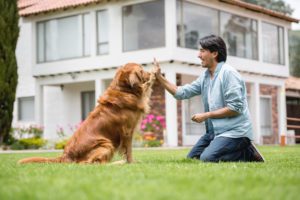When Should My Puppy Start Obedience Training
If you’re a first time puppy parent, you’re probably wondering when you can start your pup in obedience training. Training is the difference between a dog who will follow your commands, and one who doesn’t understand what you want him to do. Not training your dog is doing him a disservice. Lots of dogs enjoy their training time, and done right, it can be a fun bonding experience for you and your friend.
That said, puppies do a lot of learning in their first few months. So if you have just brought home your puppy, this article will discuss starting your pupping in training.

Before Training Begins
You want to decide if you are going to go to classes with a professional trainer or if you are going to train your puppy by yourself. A professional trainer is always a great choice, but not everyone wants or can take that option. Either is okay. Dog training isn’t rocket science.
Best Age To Begin Dog Obedience Training
Right away. Puppies are like little sponges when it comes to learning during the early weeks. While you might think you should wait until they are older, this is a mistake. By the time they are 16 weeks old, they are hitting the time when they are more difficult to work with. At that age, they are like teenagers who don’t want to go to school. The first 16 weeks are when a puppy is most receptive to training. You should take advantage of this.
Tips For Training A Puppy
These tips will help in your training efforts.
Set The Stage For Wins
One important point to remember, you want to set the stage for success. You don’t want to train your puppy where there are a lot of distractions. Because the more a dog fails, the less he will want to do the exercise. He will understand if you are unhappy with him and he’ll want to avoid displeasing you. Work in small sessions and keep things positive.
Using Rewards
Use positive rewards only. This is the best and quickest way to train any dog. Punishment only creates a disaster by making your dog afraid. You’ll want to find out what your puppy loves the most…treats, food, a special toy…whatever it is, that is your reward for him. When training a dog, there is an old saying that applies 100% and that is, “You will catch more flies with sugar than vinegar.” Give your good boy, or girl, something he values and he will love you for it and do as you ask once he understands what you want. Dogs are wonderful animals and they want to please their people more than anything else. They are called our best friends for a reason.
Be Clear With Commands
Don’t use sentences. If you want him to sit, the command is “Sit.” Make it as easy as possible for him to understand what you want. Saying, “Sit,” one time, and “That’s my boy, sit for papa,” the next is the wrong approach.
Watch Your Tone
Use a calm tone of voice and keep a calm demeanor. If you are excited, your pup will be excited. Staying calm and speaking in a calm voice will help him settle down if he is excitable.
Use Consistency
Always be consistent with your cues and training. Use the same word or hand signal all the time. The first few weeks will be about consistently showing your pup the behavior you want and associating it with the commands.
Short Training Sessions
Keep a session to about five minutes of training with a total of about 15 minutes for the day. Puppies have short attention spans and you want to keep each session positive so he’ll look forward to the next session.
Be Patient
Always be patient. Give your puppy time to respond. Puppies won’t always understand what you want right away and they will make mistakes. They are growing and learning. Keep it positive and fun and he’ll want to work with you.
Practice In Different Locations
After your pup has had all of his vaccinations, practice his training in different places. You want your good boy to understand that his training applies everywhere, not just in the comfort of his home.
Basic Essential Obedience Commands
These are essential commands every dog needs to learn.
- Sit – this is considered one of the easiest commands to teach. Start with this one.
- Stay – don’t move to this one until your pup is an expert sitter.
- Come – this is super important to make sure you dog returns when called.
- No – another super important command to maintain control.
- Down – this is a submissive posture and therefore it’s the hardest to teach.
Other Commands You Can Teach
- Stand
- Heel
- Wait
- Off
- Drop it
- Leave it
Other Essentials
Which this isn’t considered obedience training, it’s important for your pup to learn socialization and handling. It’s crucial to make sure your puppy is socialized up through 16 weeks of age. You also want to get him accustomed to being handled, and that includes his ears and paws. You veterinarian and groomer will appreciate a dog that is easy to work with. Groom your pup regularly. Teach him that handling and grooming is a part of life and not something to fear.

Conclusion
All puppies need to begin training as soon as possible. They soak up learning in the first 16 weeks, so the sooner you can begin your fur baby on the easiest cues, the better. Follow the training tips and reward him for every achievement. Rewards are a pup’s favorite thing, food or toy, that is the best motivator you can find. Make it a fun bonding time and enjoy the sessions. Keep training to short increments and before you know it, your little guy or gal will have learned the basics and be ready to take on bigger challenges, with his favorite person showing him the way.
